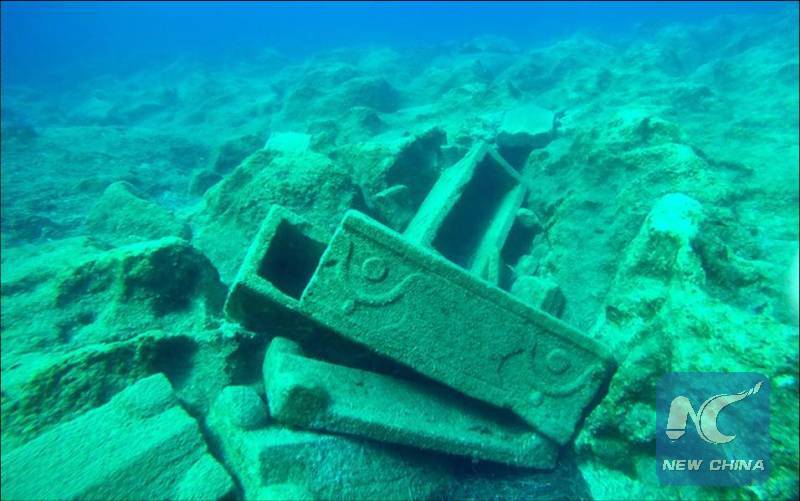
The shipwrecks of Roman Sarcophagi at the seabed near the north cape of Sapienza, off the coast of Methoni. (Photo courtesy of Ephorate of Underwater Antiquities)
by Alexia Vlachou
ATHENS, Nov. 12 (Xinhua) -- Among the most significant trade and marine centers since the ancient times near Methoni at the first leg of the Peloponnese peninsula in Greece, the island of Sapienza has been the witness of many shipwrecks as a navy passage connecting Italy to the Middle East.
As the waters in the area were very dangerous, there are dozens of shipwrecks at the bottom of the sea, including the two ancient of the Granite Columns and the Roman Sarcophagi, which are of great importance to archaeologists.
Around 1920, local fishermen located archaeological findings at the seabed near the north cape of Sapienza, off the coast of Methoni at a depth of 10 meters.
Five years later, following local fishermen's directions, Dionysios Potaris, history researcher and lawyer, traced and documented the marbles that were lying at a small distance from the north coast.
He was the first who formed the opinion that this was the wreckage of a vessel transporting antiquities.
The Greek Ephorate of Underwater Antiquities, a special department of the Greek Ministry of Culture which is responsible for the preservation of ancient relics under sea, proceeded with systematic research in the late 1970s.
According to archaeologists, this sunken vessel could date at the Roman period, since a Roman amphora was discovered close to the columns scattered in an area of about 30 square meters.
Studies of the column fragments showed that the columns were part of a building containing 16 columns from the grand Colonnaded Courtyard, built by King Herod in Caesarea, Palestine in the first century AD.
One can see that some columns are placed on the seabed one next to the other, in the same way, while others have been scattered. Archaeologists say they might have been placed in the sunken vessel.
These columns are carved in red granite. According to the petrographic analysis, this type of granite can be found in Egypt.
Also, these fragments are irregularly broken and do not fit together. Some columns have circular heads, indicating that their secondary use could be tying ships close to a pier.
North of the island of Sapienza and at a close distance from the shipwreck of the columns, a second shipwreck was traced at a depth of 15 meters.
Its cargo consisted in four stone sarcophagi with their lids. Apart from one which was fragmented, possibly during the vessel's sinking and hitting on the rock, the other three were left intact and measure 2.20 x 0.80 meters.
According to archaeologists, the sarcophagi bear a relief decoration of floral motifs, bullheads and tambours, while their lids are arched, with minimal schematized decoration only at the corners. This shipwreck is dated to the third century AD.
The Ephorate of Underwater Antiquities undertook the systematic excavation research of this shipwreck in the late 1970's.
Similar shipwrecks with sarcophagi have been traced at Syros but also in the sea region between Andros and Tinos.
For the Ephorate of Underwater Antiquities, the challenge is to continue the research activity in the area with modern technologies in order to bring more antiquities to light.
Xinhua News Agency is producing a VR (Virtual Reality) video on the underwater columnus and sarcophagi, which archaeologists say will help solve the mystery.

